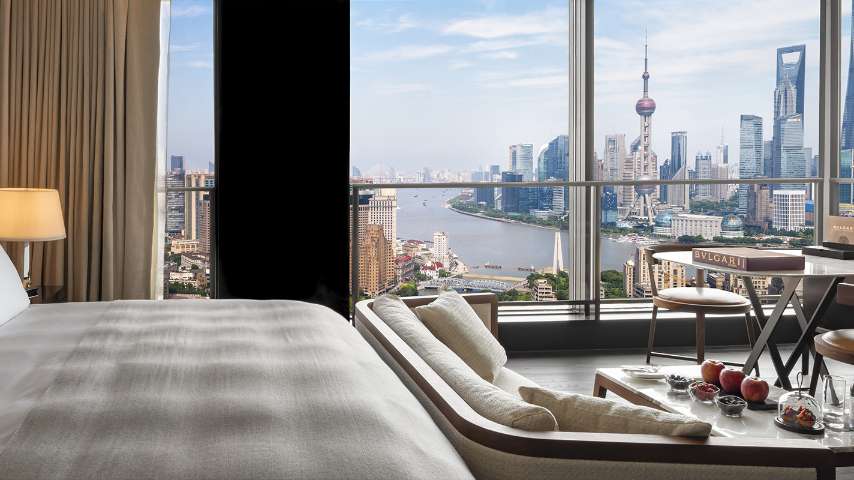

This hotel is set on a scenic riverbank which is just minutes from the iconic Bund and Shanghai City Centre. The Bvlgari Hotel Shanghai is setting new standards for luxury accommodation in one of China’s most cosmopolitan city.
The property strikes a perfect balance between nature, contemporary design and heritage architecture. The property combines intimate ambience and personalized service, including in the 82 Rooms, 19 of those are exquisite Suites. The top eight floors are occupied by the hotel of a 48-story tower that is also home to The Bvlgari Residences, the Hotel soars high above the city and attempts to bridge the past and future with its extraordinary design. Poised to be one of the city’s premier destinations for work and leisure, the Hotel is also home to a 2,000-square-metre BVLGARI Spa and fitness centre, and state-of-the-art meeting facilities.


In keeping with Shanghai’s evolution into an Asian capital of art and style, The Bvlgari Hotel Shanghai was made of as a modern masterpiece.
Personalised service is a hallmark of the Bvlgari lifestyle, the guest is given privacy of in-room check-in and optional packing and unpacking service, to around-the-clock breakfast and 24-hour personal butlers for guests of the Suites. They are provided services like the Berluti shoeshine service and a carefully-stocked minibar make guests feel at home, while a Technogym treadmill, stationary bike, and rowing machine are available in-room for private exercising. All guests are encouraged to use the Hotel’s MOMODESIGN carbon-fibre bicycles to explore the city.
Antonio Citterio Patricia Viel is the renowned Italian architectural firm that designed each Bvlgari Hotel & Resorts around the world. They created a true masterpiece combining a 48-story contemporary tower and the majestically restored 20th-Century Chamber of Commerce Shanghai building, surrounded by private Italian gardens.
Initiatives Supported by Bvlgari Hotel Shanghai
Green Initiative: The Bvlgari Hotel Shanghai is strongly committed to minimizing the environmental impact of its operations, starting from the design of its facilities. They use double sided thermal insulation glass windows and curtain wall system in the construction process efficiently decreased waste from solar heat consumption while the elaborated planned angles and colours of our mass glass windows effectively reduced the light pollution for buildings. They made efforts for sustainability and noise reduction as well. In guests’ rooms, they installed, four air-conditioners recycle heat from exhaust emissions and use it to heat up the fresh air, thus saving electricity and natural gas consumption effectively. Other responsible and preserving measures comprehend placing the environment protection card in all guests’ rooms encouraging them to reuse towels and bed sheets when staying more than one night and packing as a small gift the used BVLGARI Bottled bath amenities after taking shower at the SPA. The Bvlgari Hotel Shanghai also uses Ecolab green chemicals, which maximize the wash machine’s capacity saving energy and helping to protect the environment.
Save The Children: Bvlgari has made an effort to be a part of some of Save the Children’s key strategic areas of intervention, including emergency relief, with a targeted focus on education, as it is the company’s bold belief that no lasting development is made without education and learning. Interventions target the children most difficult to reach while tackling the growing problem of urban poverty. With the additional proceeds from the sale of the new pendant, Bvlgari is expanding the scope of its activities and focus on health by supporting Save the Children’s life-saving interventions for the most vulnerable children: newborns.
More from our site
Recent Posts
The PEAKLIFE Regatta 2025
From fashion designer Varoin Marwah’s Coastal Calm SS '25 splash show to a thrilling nautical spin on the sea, it was a magical weekend in Mumbai
From fashion designer Varoin Marwah’s Coastal Calm SS '25 splash show to a thrilling nautical…
Inside Louisiana’s Biggest Festival: 10 Things You Didn’t Know About Mardi Gras
More than a party, Mardi Gras is a cultural phenomenon!
More than a party, Mardi Gras is a cultural phenomenon!
Design Your Dream Home With These Expert Tips
A home that’s stylish, cosy, and truly yours!
A home that’s stylish, cosy, and truly yours!
Luxury in Fiji: Indulge in Paradise
From private island resorts to lavish overwater bungalows, this South Pacific paradise seamlessly blends indulgence with natural beauty
From private island resorts to lavish overwater bungalows, this South Pacific paradise seamlessly blends indulgence…
A Traveller’s Quest: Soorahi
This premium blend whisky brand aims to reflect a spirit of exploration and evolution in India’s alco-beverage landscape
This premium blend whisky brand aims to reflect a spirit of exploration and evolution in…
What’s Buzzing: Fashion, Tech, and Travel Picks You Can’t Miss!
From star-studded fashion collaborations to luxurious getaways and cutting-edge tech, here’s everything making waves this week
From star-studded fashion collaborations to luxurious getaways and cutting-edge tech, here’s everything making waves this…


